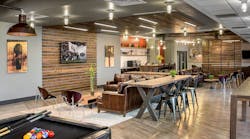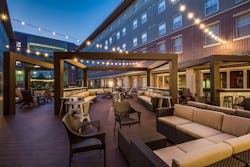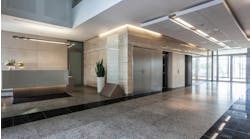Adaptive Reuse: Why Consider Converting Existing Buildings into Student Housing
The need for student housing across the country is steady as ever, with the National Multifamily Housing Council estimating that the student housing market will grow from 8.5 million beds in 2020 to 9.2 million by 2031. The continued sector growth creates several opportunities for building owners to capitalize on renewed demand.
While new construction development opportunities continue to feel fatigue due to ongoing large scale supply chain and labor challenges, one beneficial strategy for developers and building owners is to consider transforming existing assets into modern student housing through adaptive reuse.
[Related: New Adaptive Reuse Project to Radically Transform Asheville’s River Arts District]
The Benefits
To start, repurposing an existing structure vs. ground-up development can yield significant cost savings for owners. It not only reduces the initial capital investment needed, but also helps alleviate current market challenges around inflation, capitalization rates, supply chain shortages and increasing labor costs.
Another factor to consider is timing. Student housing is extremely time sensitive—if a project isn’t brought online 30-45 days ahead of the academic year, owners either need to spend additional funds on temporary housing accommodations for tenants until their units are complete or developers risk a delay in return on investment by holding the housing stock until the following year, which most often is cataclysmic to a project’s success and a developer’s reputation.
But, if you evaluate a project through the lens of adaptive reuse, the entire design and construction approach changes because projects aren’t starting from scratch. Construction timelines can be streamlined to help ensure the product is getting to market on schedule and owners are yielding maximum returns as they initially planned in their underwriting.
Also, adaptive reuse opens the door for developers to reuse and rehabilitate opportunities that exist on prime campus-adjacent real estate, and when it comes to student housing, location is everything.
For example, in College Station, Texas, where Texas A&M University is located, site location and cost of land can be prohibitive for many building owners entering the market. Kitchen & Associates worked closely with Haven Campus Communities to transform an aging dormitory asset right next to campus that was not only under-utilized, but severely out of touch with the modern student.
By taking a highly creative design approach, we renovated this dilapidated dormitory into a state-of-the-art “market rate” apartment community, now known as The Tradition at Northgate, that offers modern living accommodations, best-in-class amenities, a new amenity courtyard that incorporates a pool/hot tub, and a wide range of active and passive outdoor activities. Plus, all of this was able to be interconnected through state-of-the-art property management technology. The Tradition at Northgate will serve generations of Texas A&M students for years to come and would have never happened if the developer didn’t evaluate this opportunity through the unique lens of adaptive reuse.
[Related: How to Build Better Buildings]
Sustainability is also a primary benefit of adaptive reuse, which is not only important to the current generation of eco-conscious renters but also has several advantages for building owners. For instance, repurposing existing structures and keeping building materials, such as piping and plumbing systems, on-site significantly reduces the project’s carbon footprint and minimizes demolition debris and building waste. In fact, studies have found that repurposing structures can save up to 40% in greenhouse gas emissions. Local municipalities may also offer tax credits and other incentives for green practices and the renovation of pre-existing structures that are abandoned and ready for repositioning.
When it comes to student housing, we used to always talk about the “amenities arms race”—meaning owners are constantly trying to one-up the competition to provide students with access to the latest and greatest apartment features. However, the “amenities arms race” really isn’t a talking point anymore due to a shift in thought about designing for a “lifestyle.”
Utilizing an existing community asset or well-known campus building as student housing helps preserve the rich history and tradition of the community and university, which can be a differentiator for your property—especially if the building boasts unique features, such as historic windows, exposed beams or interesting woodwork, that can be incorporated into the design. Unique features like these are just as much an amenity because they provide the modern student the opportunity to live in a place that maintains the rich “culture” of the campus and surrounding community context. Just like The Tradition at Northgate, when you creatively design new building features to seamlessly weave together with a culturally rich existing asset, you really end up with a unique project that always stands out from the crowd.
Another great example is in Burlington City, New Jersey, where Kitchen & Associates helped transform the former Burlington City Hotel and Tavern into a mixed-use apartment community. Our designers restored the original character and architectural heritage of the building to make it a truly one-of-a-kind living experience, incorporating fully restored original windows for maximum natural light, a beautiful oak staircase and even the refurbished tavern and vintage bar into the design of the complex.
Which Buildings Work Best?
So finally, what types of existing structures could be a good fit for student housing? Public buildings with existing plumbing, HVAC and electrical systems designed for heavy commercial use and spaces on or near campus with large open interiors and appealing historic features. Examples include industrial spaces, on-campus dorms and old school buildings. As COVID-19 continues to evolve the way the country lives and works, we also anticipate an uptick in the redevelopment of under-utilized, or in some cases, completely vacant office parks, even dying shopping malls, into amenity-rich housing options that boast modern lifestyle opportunities.
In conclusion, building owners should remember that while adaptive reuse projects require careful consideration and planning, the economic and environmental benefits can definitely outweigh the risk. However, it’s critically important for owners to work with a knowledgeable architect specializing in asset preservation that truly understands their vision and can bring project plans to life in a highly creative, efficient and economical way.
About the Author:
Jason Lutz, AIA, is a Senior Associate at Kitchen & Associates and brings over 18 years of professional experience. He co-leads the Student Housing studio and market program and controls most aspects of architectural design, project management, engineering and interior design coordination for all of these projects including on and off-campus work, private, purpose-built and public private partnership ventures.
Read next: What is the Carbon Footprint of Interior Renovations?




